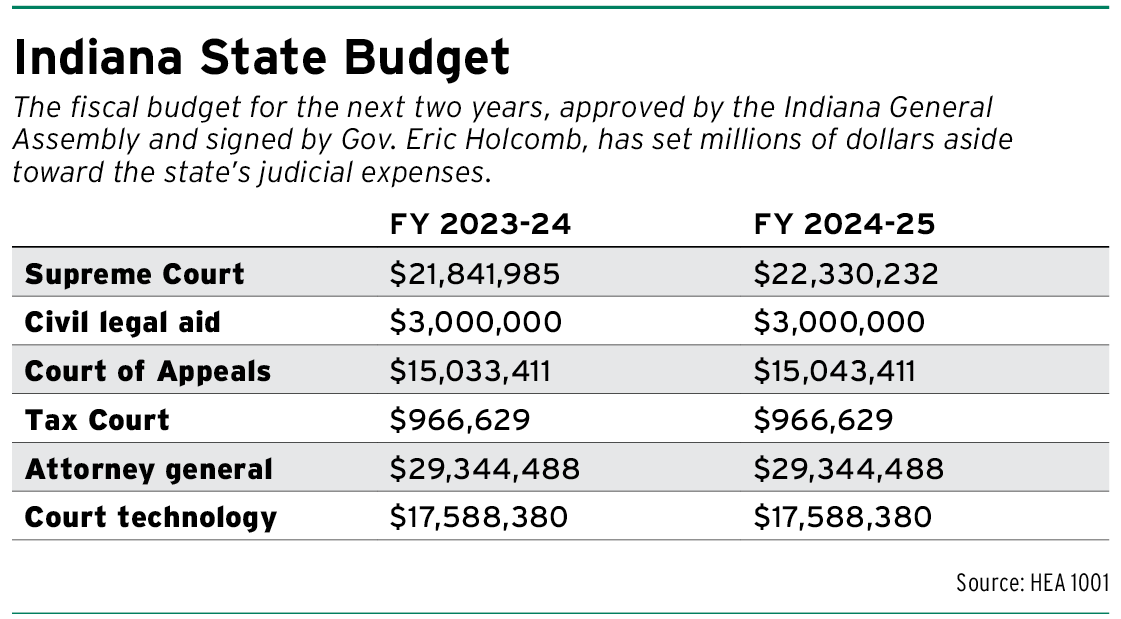Subscriber Benefit
As a subscriber you can listen to articles at work, in the car, or while you work out. Subscribe NowThe state’s multibillion-dollar biennial budget enacted during the 2023 legislative session includes increases all around for the sate’s judiciary, including additional funding for including civil legal aid, salaries and court technology.
The funding for fiscal years 2023-2024 will take effect July 1.
Indiana Supreme Court
The final budget bill allocates $21,841,985 to the Supreme Court in FY 2023-2024 and $22,330,232 in FY 2024-2025. That’s an increase from $19,400,605 in FY 2021-2022 and 2022-2023.
In a letter to lawmakers at the beginning of the 2023 budget session, Indiana Chief Justice Loretta Rush made her case for budget increases.
“Indiana’s judicial branch budget accounts for less than 1% of the state’s total budget,” she wrote. “We’re proud of that, and we don’t ask for very much very often. We’ve operated efficiently and effectively for the past six years, for example, without any additional appropriations for our operations during that time. And we did the same during the pandemic without the benefit of American Rescue Plan funding.”
A primary issue Rush raised to the Legislature was the need for additional funding for court technology.
The final budget passed by lawmakers allocates $17,588,380 per year to the Indiana Office of Court Technology, which supports the appellate courts and trial courts all around the state. That’s an annual $3 million increase over the last biennial budget.
In her letter, Rush said the judiciary was seeking a net increase of $2.08 million for court tech, “which would be achieved by returning to the State the Court’s residual revenue from the State User Fee Fund which has averaged $12.5 million over the last five years.”
“… (O)ur Court technology office is the lynchpin to so many public safety efforts — it is the means by which our court system stayed afloat during the pandemic by shifting to Zoom hearings statewide and maximizing statewide electronic filing,” she wrote, listing various court technology efforts including risk assessment tools, a protection order registry and the development of a statewide jail management system, among others.
Speaking to Indiana Lawyer, Rush also noted that the Odyssey online case management system is free to search, while the federal PACER system is fee-based.
“It means a lot to the court to have free, transparent access, but there’s a cost,” she said.
“There’s a lot that the legislature asks us to do,” she added.
Judicial salaries also saw a bump in this year’s biennial budget. A total of $97,008,265 was allocated in FY 2023-2024 while $99,627,132 was allocated in FY 2024-2025 to local judges’ salaries.
In FY 2021-2022 and FY 2022-2023, those allocations $76,075,172 and $76,078,664, respectively.
The allocation for county prosecutors’ salaries also increased to $34,670,665 and $35,794,283 in the 2023 budget bill.
Civil legal aid
In previous years, $1.5 million has been allocated annually for civil legal aid.
But this year, the Legislature increased that allocation to $3 million annually.

“We’re really excited about that,” Chuck Dunlap, Indiana Bar Foundation president and CEO, said.” The court did a lot of work and outreach. And, you know, we were really just thrilled that we were able to really follow their lead and help to support that. In July, when the new fiscal year starts, we’ll be able to distribute that much more to all of the various legal aid organizations that are doing work around the state.”
In her letter, Rush noted the Civil Legal Aid Fund, which the bar foundation administers, was initially allocated $1 million annually when it was created in 1997. That amount increased to an annual allocation of $1.5 million in 2007.
“In the fifteen years since, it has not changed, despite an increased need,” she wrote. “But state dollars invested in helping Hoosiers resolve their legal problems will pay exponential economic dividends for individuals and communities through increased housing stability, stronger income and property tax bases, and individual employability and community work force depth, and family stability and growth.”
Dunlap noted the increased allocation for civil legal aid with in the governor’s budget, and the initial budget passed by the House also included the $3 million annual allocation.
“Not only did it come through, it seemed like it was bipartisan and strongly supported,” he said.
So that’s obviously a great thing as well.”
The largest area of demand for civil legal aid is in family law, Dunlap said.
“The demand just always outstrips the supply of attorneys and the ability to do this to meet the demand, frankly,” he said. “So having this additional support is just so welcoming. It’s so crucial, and it’s really going to help a lot more people.”
Court of Appeals of Indiana
The Court of Appeals of Indiana was allocated $15,033,411 in FY 2023-2024 and $15,043,411in FY 2024-2025. That’s an increase from $12,734,076 annually in the 2021 biennial budget.
That increase accounts for a bump in salaries, according to COA Chief Judge Robert Altice.
“And that’s good, especially the timing coming out of the pandemic support, we want to make sure we’re not only retain the people that we have, but when we’re looking for new employees, that we can obtain those new employees, because our packages are at least competitive,” Altice said. “It’s still not what they can do in the private sector. But at least seems to be doing OK for us right now.”
The other use of the COA’s budget increase is going to three security officers. Previously, the court used state and Capitol Police officers, but they weren’t always available.
While nothing bad has happened, Altice said there have been a few incidents that made judges feel uncomfortable.
“I think certain judges have felt uncomfortable with who shows up at these hearings, whether it be the defendant who has been released, but is still fighting his conviction,” Altice said.

The rest of the appellate court’s budget goes toward miscellaneous items such as paper and ink for the copier machine and the IT department. Some of the funds also go toward the court’s traveling oral arguments, known as Appeals on Wheels. Altice noted the appellate court recently received the National Center for State Courts 2023 Sandra Day O’Connor Award for the Advancement of Civics for the Appeals on Wheels program.
“It’s something we’re very, very proud of,” he said.
Indiana Tax Court
The Indiana Tax Court received $966,629 annually for the next two years. Judge Martha Blood Wentworth said the majority of that is for salaries and the lease for the court’s space in the PNC Center in downtown Indianapolis.
In the past two years, Wentworth said 82% of the Tax Court’s budget went toward salaries. This year, it will be 84%.
When she first became judge more than a decade ago, Wentworth testified before the Legislature, explaining why the Tax Court needed a budget increase. Since then, when budget session comes around, the chief justice has submitted requests on the Tax Court’s behalf.•
Please enable JavaScript to view this content.

